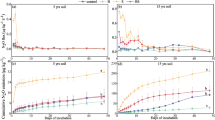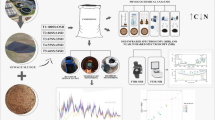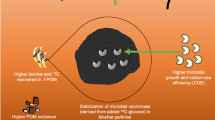Abstract
Litter from Amorpha fruticosa, a potential phytoremediating plant, was collected and used in a decomposition experiment that involved the litterbag in soil polluted by crude oil. The dynamics of the biological properties of soil and the nutrient release of the litter were detected. The results indicated that (1) in lightly polluted soil (LP, petroleum concentration was 15 g kg−1), the bacteria (including actinomycetes), and fungi populations were significant higher than those in unpolluted soil (CK) at the 1st month after pollution, and the bacteria (including actinomycetes) populations were higher than those in the CK at the 6th and 12th months. In moderately polluted soil (MP, 30 g kg−1), the bacteria (including actinomycetes) populations were higher than those in the CK at the 1st and 6th months, whereas only the actinomycetes population was greater than that in the CK at the 12th month. In seriously polluted soil (SP, 45 g kg−1), only the fungi population was higher than that in the CK at the 6th month. (2) The activities of soil protease, carboxymethyl cellulase, and sucrase were generally inhibited in polluted soil. Peroxidase activity was generally inhibited in the LP and MP soil, and polyphenol oxidase activity was inhibited in the SP soil at 6–12 months. (3) At the end of litter decomposition, the LP soil significantly increased the release rate of all nutrients, except for K. The MP soil reduced the release rate of Fe and Mn, whereas it increased that of C and Cu. The SP soil decreased the release rate of all nutrients except for Cu and Zn. In conclusion, SP by crude oil would lead to limitations in the release of nutrients from the litter and to decreases in the community stability of a phytoremediating plant. A. fruticosa could only be used in phytoremediation of polluted soil at concentrations below 45 g kg−1 (crude).



Similar content being viewed by others
References
Andrade M, Covelo E, Vega F, Marcet P (2004) Effect of the prestige oil spill on salt marsh soils on the coast of Galicia (northwestern Spain). J Environ Qual 33:2103–2110
Andreoni V, Cavalca L, Rao MA, Nocerino G, Bernasconi S, Dell’Amico E, Colombo M, Gianfreda L (2004) Bacterial communities and enzyme activities of PAHs polluted soils. Chemosphere 57:401–412
Bao S (1996) Soil agro-chemistrical analysis. China Agriculture Press, Beijing (in Chinese)
Bento RA, Saggin-Júnior OJ, Pitard RM, Straliotto R, Da Silva EMR, de Lucena Tavares SR, Volpon AGT (2012) Selection of leguminous trees associated with symbiont microorganisms for phytoremediation of petroleum-contaminated soil. Water Air Soil Pollut 223:5659–5671
Berg B, McClaugherty C (2014) Plant litter decomposition, humus formation, carbon sequestration. Springer, Berlin
Blakely J, Neher D, Spongberg A (2002) Soil invertebrate and microbial communities, and decomposition as indicators of polycyclic aromatic hydrocarbon contamination. Appl Soil Ecol 21:71–88
Bramley-Alves J, Wasley J, King CK, Powell S, Robinson SA (2014) Phytoremediation of hydrocarbon contaminants in subantarctic soils: an effective management option. J Environ Manag 142:60–69
Cajthaml T, Erbanová P, Kollmann A, Novotný Č, Šašek V, Mougin C (2008) Degradation of PAHs by ligninolytic enzymes of Irpex lacteus. Folia Microbiol 53:289–294
Eze CN, Ogbonna JC, Anyanwu CU, Eze EA (2013) Determination of the relative abundance and distribution of bacteria and fungi in Bonny light crude oil-contaminated sandy loam soil. Sci Res Essays 8:375–381
Franco I, Contin M, Bragato G, De Nobili M (2004) Microbiological resilience of soils contaminated with crude oil. Geoderma 121:17–30
Ge GF, Zheng B, Wang J, Gao HJ (2013) Effect of phenanthrene pollution with one-time and cumulative patterns on soil enzymatic activity. J Nucl Agric Sci 27:1560–1566 (in Chinese)
Guan SY (1986) Soil enzyme and research technology. Agriculture Press, Beijing (in Chinese)
Guo H, Yao J, Cai M, Qian Y, Guo Y, Richnow HH, Blake RE, Doni S, Ceccanti B (2012) Effects of petroleum contamination on soil microbial numbers, metabolic activity and urease activity. Chemosphere 87:1273–1280
Joshi SR, Kumar R, Saikia P, Bhagobaty RK, Thokchom S (2010) Impact of roadside pollution on microbial activities in sub-tropical forest soil of North East India. Res J Environ Sci 4:280–287
Kirk JL, Klironomos JN, Lee H (2005) The effects of perennial ryegrass and alfalfa on microbial abundance and diversity in petroleum contaminated soil. Environ Pollut 133:455–465
Liu WX, Luo YM, Teng Y, Li ZG, Wu LH (2007) Eco-risk assessment and bioremediation of petroleum contaminated soil. II. Changes in physico-chemical properties and microbial ecology of petroleum contaminated soil. Acta Pedologica Sin 44:848–853 (in Chinese)
Liu R, Xiao N, Wei S, Zhao L, An J (2014) Rhizosphere effects of PAH-contaminated soil phytoremediation using a special plant named Fire Phoenix. Sci Total Environ 473:350–358
Lv GF, Zhao J, Zhao L, Liao YN (1997) Primary study on the evaluation of raw oil pollution using soil enzyme activities in typical steppe region. Acta Sci Nat Univ NeiMongol 28:687–691 (in Chinese)
Ma J, Shen J, Liu Q, Fang F, Cai H, Guo C (2014) Risk assessment of petroleum-contaminated soil using soil enzyme activities and genotoxicity to Vicia faba. Ecotoxicology 23:665–673
Maliszewska-Kordybach B, Smreczak B (2003) Habitat function of agricultural soils as affected by heavy metals and polycyclic aromatic hydrocarbons contamination. Environ Int 28:719–728
McKinley VL, Federle TW, Vestal JR (2003) Effects of petroleum hydrocarbons on plant litter microbiota in an arctic lake. Appl Environ Microbial 43:129–135
Nanjing Institute of Soil Science CAS (1985) Analysis of soil microorganism. Science Press, Beijing (in Chinese)
Ogboghodo I, Iruaga E, Osemwota I, Chokor J (2004) An assessment of the effects of crude oil pollution on soil properties, germination and growth of maize (Zea mays) using two crude types-Forcados light and Escravos light. Environ Monit Assess 96:143152
Pan F, Geng QJ, Chu HJ, Wang LL (2011) Analysis of polycyclic aromatic hydrocarbons in petroleum contaminated soils and its ecological risk assessment. J Ecol Rural Environ 27:42–47 (in Chinese)
Qasemian L, Guiral D, Belghazi M, Ferre E, Gros R, Farnet A (2011) Identification of various laccases induced by anthracene and contribution to its degradation in a Mediterranean coastal pine litter. Chemosphere 84:1321–1328
Qasemian L, Guiral D, Ziarelli F, Ruaudel F, Farnet A (2012a) Does anthracene affect microbial activities and organic matter decomposition? A comparative study in Pinus halepensis litters from Mediterranean coastal and inland areas. Chemosphere 89:548–555
Qasemian L, Guiral D, Ziarelli F, Van Dang TK, Farnet A (2012b) Effects of anthracene on microbial activities and organic matter decomposition in a Pinus halepensis litter from a Mediterranean coastal area. Soil Biol Biochem 46:148–154
Rahn JH (2012) A test method for the evaluation of soil microbial health in a petroleum hydrocarbon contaminated boreal forest soil. Dissertation, The University of Guelph
Robertson SJ, McGill WB, Massicotte HB, Rutherford PM (2007) Petroleum hydrocarbon contamination in boreal forest soils: a mycorrhizal ecosystems perspective. Biol Rev Camb Philos Soc 82:213–240
Robertson SJ, Kennedy NM, Massicotte HB, Rutherford PM (2010) Enhanced biodegradation of petroleum hydrocarbons in the mycorrhizosphere of sub-boreal forest soils. Environ Microbiol Rep 2:587–593
Schimel J, Hattenschwiler S (2007) Nitrogen transfer between decomposing leaves of different N status. Soil Biol Biochem 39:1428–1436
Serrano A, Tejada M, Gallego M, Gonzalez JL (2009) Evaluation of soil biological activity after a diesel fuel spill. Sci Total Environ 407:4056–4061
Shen GQ, Lu YT, Zhou QX, Hong JB (2005) Interaction of polycyclic aromatic hydrocarbons and heavy metals on soil enzyme. Chemosphere 61:1175–1182
Tejada M, González J (2007) Application of different organic wastes on soil properties and wheat yield. Agron J 99:1597–1606
Thavamani P, Malik S, Beer M, Megharaj M, Naidu R (2012) Microbial activity and diversity in long-term mixed contaminated soils with respect to polyaromatic hydrocarbons and heavy metals. J Environ Manag 99:10–17
Trevors JA (2010) Microbial genomics, DNA, and pollution: what’s next? Water Air Soil Pollut 205:119
Wang XY, Feng J, Zhao JM (2010) Effects of crude oil residuals on soil chemical properties in oil sites, Momoge Wetland, China. Environ Monit Assess 161:271–280
Wyszkowska J, Wyszkowski M (2010) Activity of soil dehydrogenases, urease, and acid and alkaline phosphatases in soil polluted with petroleum. J Toxicol Environ Health 73:1202–1210
Yu Q, Zhang XX, Liu ZW, Wang WX, Zhang ZY, Wang N (2015) Remediation effects of urban greening-tree litters on petroleum-contaminated soil in oil producing region of northern Shaanxi. J Agro-Environ Sci 34:50–57 (in Chinese)
Zhang LJ (2013) The selection of tree and grass species to tolerate soil contamination in the Loess Plateau in Northern Shaanxi. Dissertation, Northwest A&F University (in Chinese)
Zhou F, Bai J, Li YY (2012) Relationship of microbial activity and petroleum pollution of Liaohe river delta reed wetland. Trans Oceanol Limnol 35:159–166 (in Chinese)
Author information
Authors and Affiliations
Corresponding author
Additional information
Responsible editor: Zhihong Xu
Rights and permissions
About this article
Cite this article
Zhang, X., Liu, Z., Luc, N. et al. Dynamics of the biological properties of soil and the nutrient release of Amorpha fruticosa L. litter in soil polluted by crude oil. Environ Sci Pollut Res 22, 16749–16757 (2015). https://doi.org/10.1007/s11356-015-4874-z
Received:
Accepted:
Published:
Issue Date:
DOI: https://doi.org/10.1007/s11356-015-4874-z




